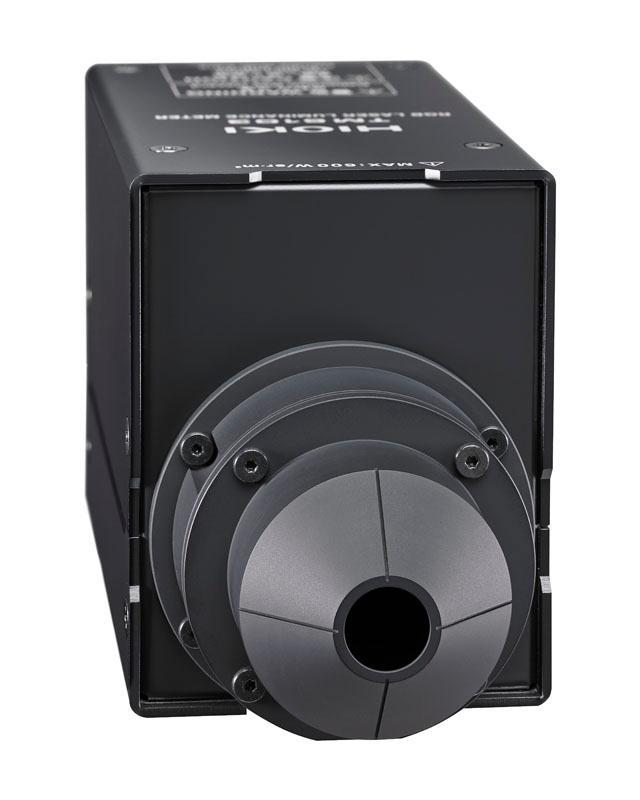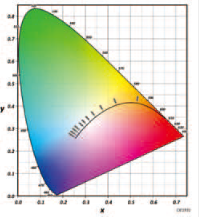Product Jun. 14, 2017
Hioki Introduces Three Measuring Instruments for RGB Lasers
Innovative Instruments Offer New Approach to Adjusting the White Balance of Laser Displays
June 13, 2017 - Nagano, Japan
Hioki is pleased to announce the launch of three measuring instruments designed specifically for use with displays that utilize RGB* lasers. The newly introduced RGB Laser Illuminance Meter TM6102, RGB Laser Luminance Meter TM6103, and Optical Power Meter TM6104 are capable of accurately evaluating the white balance of displays that use lasers by measuring centroid wavelength and optical power, which are key characteristics in the evaluation of laser light sources. The new instruments promise to play an important role in processes designed to adjust and inspect RGB lasers, which are expected to enter into increasingly widespread use going forward.
*RGB: A method for expressing a broad range of colors by mixing the three primary colors of red, green, and blue.
DEVELOPMENT BACKGROUND
LED backlights are currently the most commonly used light source for displays. However, RGB lasers are forecast to take over that role in the future in products such as projectors and head-up displays. As a result, the RGB laser market is poised to grow significantly, with forecasts calling for it to reach 10 trillion Japanese Yen (91 billion USD) in 2020 and more than 70 trillion Japanese Yen (636 billion USD) by 2040.
To accommodate testing and adjustment of the RGB lasers that are expected to enter into increasingly widespread use going forward, Hioki developed the Discrete Centroid Wavelength Method, a new technique for directly measuring the centroid wavelength and optical power of laser light sources. This approach makes it possible to accurately adjust the white balance of displays that use RGB lasers.
ADJUSTMENT OF CHROMATICITY AND WHITE BALANCE
Chromaticity provides a means of expressing the characteristics of the color of light as values on an X-Y coordinate grid. When these values are plotted on the X-axis and Y-axis, the result is a chromaticity graph.
Until now, display developers and manufacturers have set the white point projected by a light source as a specific chromaticity value and then adjusted the white balance based on values measured with a color illuminometer. However, the characteristics of the laser light sources that are expected to enter into widespread use in the future introduce an element of error into the conventional method, raising the possibility that the same chromaticity values may be associated with colors that look different to the human eye.
Hioki has addressed this issue with these three instruments by adopting the proprietary Discrete Centroid Wavelength Method, which makes it possible to accurately adjust the white balance of laser light sources.
KEY FEATURE
1. Accurate measurement of RGB lasers using the Discrete Centroid Wavelength Method
The three newly introduced instruments adopt Hioki’s Discrete Centroid Wavelength Method in order to separate white incident light consisting of R, G, and B components into three wavelength regions using an optical device and then to simultaneously measure the centroid wavelength and optical power (radiant quantity) for each. A total of 11 optical characteristics such as chromaticity and luminous quantity are then calculated by means of color-matching functions based on those values. This method makes it possible to accurately measure chromaticity and luminous quantity so that the white balance of laser light sources can be accurately adjusted.
Principal Measurement Specifications
*RGB center wavelength measurement resolution: 0.01 nm
*Chromaticity X-Y coordinate output resolution: 0.00001
2. Reduction of adjustment labor-hours by half with White Balance Navigation
White Balance Navigation, a function that assists in adjusting white balance, makes it possible to adjust light sources to deliver the desired color and brightness simply by setting the target color (chromaticity) and brightness (luminous quantity) along with allowable ranges for each and then adjusting the strength (radiant quantity) of each light source to the indicated range obtained from measurement. In this way, the number of labor-hours required for adjustment can be reduced by half compared to the conventional method.
3. Physical quantity correction functions that minimize instrument differences
When using multiple measuring instruments, instrument-specific differences have an effect on measured values. These three instruments address this issue by providing functionality for correcting physical quantities in the form of centroid wavelength offset correction and radiant quantity gain correction. By making it possible to correct readings based on a standard laser light source that the customer uses as a reference, this functionality minimizes the effects of instrument differences on measured values.
PRINCIPAL MEASUREMENT PARAMETERS BY PRODUCT
* RGB Laser Illuminance Meter TM6102: Radiant illumination, centroid wavelength, illuminance, chromaticity
* RGB Laser Luminance Meter TM6103: Radiant illumination, centroid wavelength, luminance, chromaticity
* Optical Power Meter TM6104: Radiant flux (optical power), centroid wavelength, luminous flux, chromaticity
PRINCIPAL TARGET MARKETS
* Manufacturers of head-up displays
* Manufacturers of head-mounted displays
* Manufacturers of pico-projectors
About HIOKI
Established in 1935, HIOKI E.E. CORPORATION (TSE: 6866) has grown to become a world leader in providing consistent delivery of test and measuring instruments through advanced design, manufacturing, and sales and services. By offering over 200 main products characterized by safety and quality while meeting an expansive range of applications, we aim to contribute to the efficiency and value of our customers' work in research and development, production and electrical maintenance. HIOKI products and services are available around the world through our extensive network of subsidiaries and distributors. Information about HIOKI is available at www.hioki.com.
June 13, 2017 - Nagano, Japan
Hioki is pleased to announce the launch of three measuring instruments designed specifically for use with displays that utilize RGB* lasers. The newly introduced RGB Laser Illuminance Meter TM6102, RGB Laser Luminance Meter TM6103, and Optical Power Meter TM6104 are capable of accurately evaluating the white balance of displays that use lasers by measuring centroid wavelength and optical power, which are key characteristics in the evaluation of laser light sources. The new instruments promise to play an important role in processes designed to adjust and inspect RGB lasers, which are expected to enter into increasingly widespread use going forward.
*RGB: A method for expressing a broad range of colors by mixing the three primary colors of red, green, and blue.
DEVELOPMENT BACKGROUND
LED backlights are currently the most commonly used light source for displays. However, RGB lasers are forecast to take over that role in the future in products such as projectors and head-up displays. As a result, the RGB laser market is poised to grow significantly, with forecasts calling for it to reach 10 trillion Japanese Yen (91 billion USD) in 2020 and more than 70 trillion Japanese Yen (636 billion USD) by 2040.
To accommodate testing and adjustment of the RGB lasers that are expected to enter into increasingly widespread use going forward, Hioki developed the Discrete Centroid Wavelength Method, a new technique for directly measuring the centroid wavelength and optical power of laser light sources. This approach makes it possible to accurately adjust the white balance of displays that use RGB lasers.
ADJUSTMENT OF CHROMATICITY AND WHITE BALANCE
Chromaticity provides a means of expressing the characteristics of the color of light as values on an X-Y coordinate grid. When these values are plotted on the X-axis and Y-axis, the result is a chromaticity graph.
Until now, display developers and manufacturers have set the white point projected by a light source as a specific chromaticity value and then adjusted the white balance based on values measured with a color illuminometer. However, the characteristics of the laser light sources that are expected to enter into widespread use in the future introduce an element of error into the conventional method, raising the possibility that the same chromaticity values may be associated with colors that look different to the human eye.
Hioki has addressed this issue with these three instruments by adopting the proprietary Discrete Centroid Wavelength Method, which makes it possible to accurately adjust the white balance of laser light sources.
KEY FEATURE
1. Accurate measurement of RGB lasers using the Discrete Centroid Wavelength Method
The three newly introduced instruments adopt Hioki’s Discrete Centroid Wavelength Method in order to separate white incident light consisting of R, G, and B components into three wavelength regions using an optical device and then to simultaneously measure the centroid wavelength and optical power (radiant quantity) for each. A total of 11 optical characteristics such as chromaticity and luminous quantity are then calculated by means of color-matching functions based on those values. This method makes it possible to accurately measure chromaticity and luminous quantity so that the white balance of laser light sources can be accurately adjusted.
Principal Measurement Specifications
*RGB center wavelength measurement resolution: 0.01 nm
*Chromaticity X-Y coordinate output resolution: 0.00001
2. Reduction of adjustment labor-hours by half with White Balance Navigation
White Balance Navigation, a function that assists in adjusting white balance, makes it possible to adjust light sources to deliver the desired color and brightness simply by setting the target color (chromaticity) and brightness (luminous quantity) along with allowable ranges for each and then adjusting the strength (radiant quantity) of each light source to the indicated range obtained from measurement. In this way, the number of labor-hours required for adjustment can be reduced by half compared to the conventional method.
3. Physical quantity correction functions that minimize instrument differences
When using multiple measuring instruments, instrument-specific differences have an effect on measured values. These three instruments address this issue by providing functionality for correcting physical quantities in the form of centroid wavelength offset correction and radiant quantity gain correction. By making it possible to correct readings based on a standard laser light source that the customer uses as a reference, this functionality minimizes the effects of instrument differences on measured values.
PRINCIPAL MEASUREMENT PARAMETERS BY PRODUCT
* RGB Laser Illuminance Meter TM6102: Radiant illumination, centroid wavelength, illuminance, chromaticity
* RGB Laser Luminance Meter TM6103: Radiant illumination, centroid wavelength, luminance, chromaticity
* Optical Power Meter TM6104: Radiant flux (optical power), centroid wavelength, luminous flux, chromaticity
PRINCIPAL TARGET MARKETS
* Manufacturers of head-up displays
* Manufacturers of head-mounted displays
* Manufacturers of pico-projectors
About HIOKI
Established in 1935, HIOKI E.E. CORPORATION (TSE: 6866) has grown to become a world leader in providing consistent delivery of test and measuring instruments through advanced design, manufacturing, and sales and services. By offering over 200 main products characterized by safety and quality while meeting an expansive range of applications, we aim to contribute to the efficiency and value of our customers' work in research and development, production and electrical maintenance. HIOKI products and services are available around the world through our extensive network of subsidiaries and distributors. Information about HIOKI is available at www.hioki.com.
 TM6103 RGB LASER LUMINANCE METER
TM6103 RGB LASER LUMINANCE METER
 Chromaticity Graph
Chromaticity Graph
